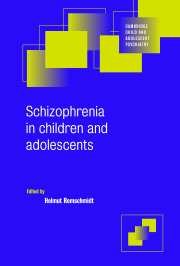Book contents
- Frontmatter
- Contents
- List of contributors
- Preface
- 1 Childhood psychosis and schizophrenia: a historical review
- 2 Definition and classification
- 3 Epidemiology of early onset schizophrenia
- 4 Childhood schizophrenia: developmental aspects
- 5 Diagnosis and differential diagnosis
- 6 Genetic aspects
- 7 Neurobehavioral perspective
- 8 Psychosocial factors: the social context of child and adolescent onset schizophrenia
- 9 Treatment and rehabilitation
- 10 Course and prognosis
- Index
3 - Epidemiology of early onset schizophrenia
Published online by Cambridge University Press: 23 October 2009
- Frontmatter
- Contents
- List of contributors
- Preface
- 1 Childhood psychosis and schizophrenia: a historical review
- 2 Definition and classification
- 3 Epidemiology of early onset schizophrenia
- 4 Childhood schizophrenia: developmental aspects
- 5 Diagnosis and differential diagnosis
- 6 Genetic aspects
- 7 Neurobehavioral perspective
- 8 Psychosocial factors: the social context of child and adolescent onset schizophrenia
- 9 Treatment and rehabilitation
- 10 Course and prognosis
- Index
Summary
Introduction
The diagnosis of schizophrenia is rarely made in childhood, and it seems almost certain that prepubertal onset of schizophrenia is rare. However, for decades, the disorders now subsumed under the label of autism spectrum disorders (Wing, 1996b) or pervasive developmental disorders (APA, 1994) – themselves relatively rare conditions – were referred to as “childhood schizophrenia” (Bender, 1969), leading to difficulty in separating out “true” cases of schizophrenia in older studies. Only after the publication by Kolvin of a study showing two fairly distinct peaks for age of onset of prepubertal “psychosis” (Kolvin, 1971) did the current emphasis of a split between early childhood autism and later onset cases of schizophrenia begin to develop (Rutter, 1978). It has been – almost universally – agreed for two decades that childhood autism and schizophrenia are qualitatively different conditions and that early onset pervasive developmental disorders (such as Kanner's variant of autism) do not represent precursors of schizophrenia (Gillberg, 1990). However, in the most recent past, the emergence of the concept of Asperger syndrome (Wing, 1981) and the upsurge in publications on early onset schizophrenia – and particularly on the antecedents of disorders diagnosed as childhood schizophrenia (Watkins et al., 1988) – have led to a reopening of the debate as to whether or not autism spectrum disorders (of which Asperger syndrome is believed to constitute one part) should be seen as totally distinct from schizophrenia with prepubertal (or later) onset. All these issues need to be taken into account when considering matters to do with the epidemiology of early onset schizophrenia.
Keywords
- Type
- Chapter
- Information
- Schizophrenia in Children and Adolescents , pp. 43 - 59Publisher: Cambridge University PressPrint publication year: 2000
- 2
- Cited by



